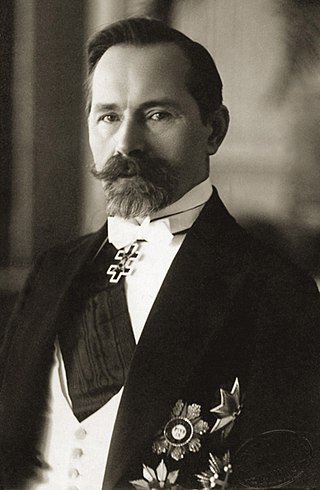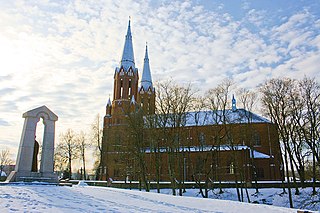
Antanas Smetona was a Lithuanian intellectual, journalist and politician who served as the first president of Lithuania from 1919 to 1920 and again from 1926 as a de facto dictator until the Soviet occupation of Lithuania in 1940. Referred to as the "Leader of the Nation" during his presidency, Smetona is recognised as one of the most important Lithuanian political figures between World War I and World War II, and a prominent ideologist of Lithuanian nationalism and the movement for national revival.

The coat of arms of Lithuania is a mounted armoured knight holding a sword and shield, known as Vytis. Since the early 15th century, it has been Lithuania's official coat of arms and is one of the oldest European coats of arms. It is also known by other names in various languages, such as Waykimas, Pagaunė in the Lithuanian language or as Pogonia, Pogoń, Пагоня in the Polish, and Belarusian languages. Vytis is translatable as Chase, Pursuer, Knight or Horseman, similar to the Slavic vityaz. Historically – raitas senovės karžygys or in heraldry – raitas valdovas.

Balys Sruoga was a Lithuanian poet, playwright, critic, and literary theorist.

Antanas Škėma was a Lithuanian writer, playwright, stage actor and director. His best known work is the novel Balta drobulė.
The city of Vilnius, the capital and largest city of Lithuania, has an extensive history starting from the Stone Age. The city has changed hands many times between Imperial and Soviet Russia, Napoleonic France, Imperial and Nazi Germany, Interwar Poland, and Lithuania.

Vilnius Region[a] is the territory in present-day Lithuania and Belarus that was originally inhabited by ethnic Baltic tribes and was a part of Lithuania proper, but came under East Slavic and Polish cultural influences over time.

The Lithuanian Wars of Independence, also known as the Freedom Struggles, refer to three wars Lithuania fought defending its independence at the end of World War I: with Bolshevik forces, Bermontians, and Poland. The wars delayed international recognition of independent Lithuania and the formation of civil institutions.

Lithuanian book smugglers or Lithuanian book carriers smuggled Lithuanian language books printed in the Latin alphabet into Lithuanian-speaking areas of the Russian Empire, defying a ban on such materials in force from 1864 to 1904. In Lithuanian knygnešys literally means "the one who carries books". Opposing imperial Russian authorities' efforts to replace the traditional Latin orthography with Cyrillic, and transporting printed matter from as far away as the United States to do so, the book smugglers became a symbol of Lithuanians' resistance to Russification.
Russians in Lithuania number about 146,000 people, according to the Lithuanian estimates of 2023, or 5.1% of the total population of Lithuania.

Lithuanian literature concerns the art of written works created by Lithuanians throughout their history.

Anykščiai is a ski resort city in Lithuania, 20 miles west of Utena. The Roman Catholic Church of St. Matthias in Anykščiai is the tallest church in Lithuania, with spires measuring 79 metres in height. Anykščiai has a resort status in Lithuania and is a popular destination of domestic tourism.

Iron Wolf was a semi-official Lithuanian militarized organization active in 1928–1930, led by Prime Minister Augustinas Voldemaras. Established at the end of 1927 by the ruling Lithuanian Nationalist Union to help suppress its opposition, it was inspired by the Blackshirts, an Italian fascist organization. The organization was secret; it was officially a sports union from May 1928. The organization spied on its political opponents, engaged in limited physical coercion, and launched propaganda initiatives. It had more than 4,000 members.

Lietuvos aidas is a daily newspaper in Lithuania. It was established on September 6, 1917, by Antanas Smetona, and became the semi-official voice of the newly formed Lithuanian government. When the government evacuated from Vilnius to the temporary capital, Kaunas, it ceased publication. The newspaper was revived in 1928 as the newspaper of the Lithuanian government and became the most popular newspaper in Lithuania. At its peak, it published three daily editions with combined circulation of 90,000 copies. World War II disrupted its publication. In 1990, after Lithuania declared independence from the Soviet Union, the newspaper once again became the official newspaper of the Supreme Council of the Republic of Lithuania. At the end of 1992, its circulation reached 103,000 copies. However, it was soon privatized and faced shrinking readership, financial difficulties, and other controversies. In April 2006, bankruptcy proceedings were initiated by the State Tax Inspectorate when its tax debts reached more than 4 million litas. The company was liquidated in 2015, but the newspaper continues to be published by a non-profit organization.

Films have been made in Lithuania since the early twentieth century.

The Vilna Governorate was a province (guberniya) of the Northwestern Krai of the Russian Empire. In 1897, the governorate covered an area of 41,907.9 square kilometres (16,180.7 sq mi) and had a population of 1,591,207 inhabitants. The governorate was defined by the Minsk Governorate to the south, the Grodno Governorate to the southwest, the Suwałki Governorate to the west, the Kovno and Courland Governorates to the north, and the Vitebsk Governorate to the east. The capital was located in Vilna (Vilnius). The city also served as the capital of Vilna Governorate-General, which existed until 1912. The area roughly corresponded to the Vilnius Region, which was later occupied by Germany, Bolsheviks, and Poland.

The Lithuanian press ban was a ban on all Lithuanian language publications printed in the Latin alphabet in force from 1865 to 1904 within the Russian Empire, which controlled Lithuania proper at the time. Lithuanian-language publications that used Cyrillic were allowed and even encouraged.
The Lithuanian conferences during World War I refer to ten conferences held by Lithuanian activists during World War I in Switzerland and Sweden. They articulated the vision of independent Lithuanian state free of Russian, German, and Polish influence and as such were an important step towards the Act of Independence of Lithuania in February 1918.
Algimantas Anicetas Bučys is a poet, prose writer, translator, literary theorist, historian and critic of Lithuanian literature, doctor of Humanities.

Sofija Smetonienė, was the wife of the first President of Lithuania Antanas Smetona and served as the First Lady of Lithuania from April 4, 1919, to June 19, 1920, and again from December 19, 1926, to June 15, 1940. Sofija was a member of the Chodakowski noble family.
America in the Bathhouse is a three-act comedy by Keturakis. The play was first published in 1895. It became the first Lithuanian-language play performed in public in present-day Lithuania when a group of Lithuanian activists staged it on 20 August 1899 in Palanga. The play depicts an episode from the everyday life of the Lithuanian village – a resourceful man swindles money from a naive woman and escapes to the United States. Due to its relevant plot, small cast, and simple decorations, the play was very popular with the Lithuanian amateur theater. It became one of the most popular and successful Lithuanian comedies of all time and continues to be performed by various troupes.















